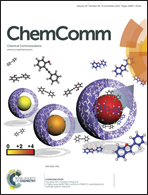Practical fluorescence detection of acrolein in human plasma via a two-step tethering approach†
Abstract
Acrolein, a cytotoxic α,β-unsaturated aldehyde and disease biomarker, was determined in plasma by means of a novel tethering strategy using Michael addition of the compound to a fluorescent dye, followed by immobilization of the product on microbeads via the aldehyde moiety. Elevation of blood acrolein was detected in mice treated with an anticancer agent cyclophosphamide, which releases acrolein upon activation. This method should be suitable for high-throughput diagnostic and clinical application.


 Please wait while we load your content...
Please wait while we load your content...